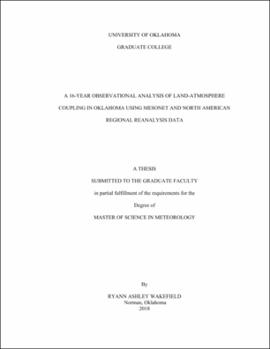| dc.contributor.advisor | Basara, Jeffrey | |
| dc.contributor.author | Wakefield, Ryann | |
| dc.date.accessioned | 2018-07-25T19:26:32Z | |
| dc.date.available | 2018-07-25T19:26:32Z | |
| dc.date.issued | 2018-08 | |
| dc.identifier.uri | https://hdl.handle.net/11244/301305 | |
| dc.description.abstract | Global “hot spots” for land atmosphere coupling have been identified through various studies. One particular region that has been identified in many of these global studies is the Southern Great Plains (SGP) of North America. Local coupling studies have identified links between boundary layer evolution and soil moisture at point locations. This analysis seeks to bridge the spatial and temporal gaps between the local and global approaches to better understand the nature of land atmosphere feedbacks during the warm season months of May through September during 2000 through 2015 using a local coupling framework. This framework was applied to the datasets to create a mesoscale climatology of land-atmosphere interactions in Oklahoma at varying temporal scales but did not adequately quantify land-atmosphere interactions. Therefore, a revised approach using standardized anomalies of previously developed metrics, Convective Triggering Potential (CTP) and low-level humidity index (HI), was developed to showcase the difference in low-level atmospheric response to extreme drought and pluvial years. Within pluvial years, unexpected differences in CTP/HI anomalies emerged suggesting differences precipitation drivers. While 2007 demonstrated characteristics of positive wet feedbacks, 2015 had behavior within the parameter space that was more similar to drought years despite having record rainfall suggesting an interannual variability in atmospheric response to soil moisture. Similarly, the CTP/HI standardized anomaly approach was able to demonstrate the atmospheric response to dry land surface conditions both locally and non-locally during drought years. At the intra-annual timescale, similar differences between drought and pluvial periods were observed. More importantly, these periods show similarities by demonstrating a greater atmospheric response to soil moisture during dry-down periods. | en_US |
| dc.language | en_US | en_US |
| dc.subject | Meteorology | en_US |
| dc.subject | Land-Atmosphere Interactions | en_US |
| dc.subject | Boundary Layer | en_US |
| dc.subject | Hydrometeorology | en_US |
| dc.title | A 16-Year Observational Analysis of Land-Atmosphere Coupling in Oklahoma Using Mesonet and North American Regional Reanalysis Data | en_US |
| dc.contributor.committeeMember | Furtado, Jason | |
| dc.contributor.committeeMember | Illston, Bradley | |
| dc.contributor.committeeMember | Klein, Petra | |
| dc.date.manuscript | 2018-07 | |
| dc.thesis.degree | Master of Science in Meteorology | en_US |
| ou.group | College of Atmospheric & Geographic Sciences::School of Meteorology | en_US |
